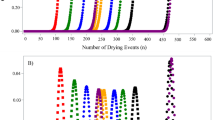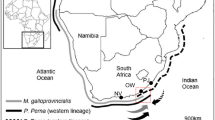Abstract
In order to understand variability in recruitment to populations of benthic and demersal marine species, it is critical to distinguish between the contributions due to variations in larval settlement versus those caused by post-settlement mortality. In this study, fine-scale (1–2 days) temporal changes in recruit abundance were followed through an entire settlement season in a temperate demersal fish in order to determine 1) how dynamic the process of recruitment is on a daily scale, 2) whether settlement and post-settlement mortality are influenced by habitat structure and conspecific density, and 3) how the relationship between settlement and recruitment changes over time. “Settlement” is considered to be the arrival of new individuals from the pelagic habitat, and “recruitment” is defined as the number of individuals surviving arbitrary periods of time after settlement. Replicate standardized habitat units were placed in 2 spatial configurations (clumped and randomly dispersed) and monitored visually for cunner (Tautogolabrus adspersus) settlement and recruitment every 1–2 days throughout the settlement season. The process of recruitment in T. adspersus was highly variable at a fine temporal scale. Changes in the numbers of recruits present on habitat units were due to both settlement of new individuals and mortality of animals previously recruited. The relative importance of these two processes appeared to change from day to day. The magnitude of the change in recruit number did not differ between the clumped and random habitats. However, post-settlement loss was significantly greater on randomly dispersed than clumped habitats. During several sampling dates, the extent of the change in recruit abundance was correlated with the density of resident conspecifics; however, on other dates no such relationship appeared to exist. Despite the presence of significant relationships between the change in recruit number and density, there was no evidence of either density-dependent mortality or settlement. Initially, there was a strong relationship between settlement and recruitment; however, this relationship weakened over time. Within 2 months after the cessation of settlement, post-settlement loss was greater than 99%, and no correlation remained between recruitment and the initial pattern of settlement. The results of this study demonstrate that the spatial arrangement of the habitat affects the rate and intensity of post-settlement loss. Counter to much current thinking, this study suggests that in order to understand the population ecology of reef fishes, knowledge of what habitats new recruits use and how mortality varies with structural aspects of the habitats is essential.
Similar content being viewed by others
References
Addicott J, Aho JM, Antolin M, Padilla DK, Richardson JS, Soluk DA (1987) Ecological neighborhoods: scaling environmental patterns. Oikos 49:340–346
Auerbach M, Simberloff D (1989) Oviposition site preference and larval mortality in a leaf-mining moth. Ecol Entomol 14:131–140
Bigelow HB, Schroeder SC (1953) Fishes of the Gulf of Maine. Fishery Bulletin of the Fish and Wildlife Service. Vol. 53. U.S. Government Printing Office, Washington. 577 pp
Booth DJ (1991) The effects of sampling frequency on estimates of recruitment of the domino damselfish Dascyllus albisella Gill. J Exp Mar Biol Ecol 145:149–159
Bradbury C (1993) Ultrasonic tracking of activity and movement patterns of female cunner, Tautogolabrus adspersus, in Broad Cove, Conception Bay, Newfoundland. M.Sc. Thesis, Memorial University of Newfoundland, St. John's, Newfoundland
Breitburg DL (1989) Demersal schooling prior to settlement by larvae of the naked goby. Env Biol Fish 26:97–103
Breitburg DL (1991) Settlement patterns and presettlement behavior of the naked goby, Gobiosoma bosci, a temperate oyster reef fish. Mar Biol 194:221–231
Caffey HM (1985) Spatial and temporal variation in settlement and recruitment of intertidal barnacles. Ecol Monog 55:313–332
Caley MJ (1993) Predation, recruitment and the dynamics of communities of coral-reef fishes. Mar Biol 117:33–43
Carr MH (1989) Effects of macroalgal assemblages on the recruitment of temperate zone reef fishes. J Exp Mar Biol Ecol 126:59–76
Carr MH (1991) Habitat selection and recruitment of an assemblage of temperate zone reef fishes. J Exp Mar Biol Ecol 146:113–137
Chapman ARO, Johnson CR (1990) Disturbance and organization of macroalgal assemblages in the Northwest Atlantic. Hydrobiologia 192:77–121
Connell JH (1985) The consequences of variation in initial vs. post-settlement mortality in rocky intertidal communities. J Exp Mar Biol Ecol 93:11–45
Connell SD, Jones GP (1991) The influence of habitat complexity on postrecruitment processes in a temperate reef fish population. J Exp Mar Biol Ecol 151:271–294
Davis AR (1988) Effects of variation in initial settlement on distribution and abundance of Podoclavella moluccensis Sluiter. J Exp Mar Biol Ecol 117:157–167
Dayton PK (1985) Ecology of kelp communities. Ann Rev Ecol Syst 16:215–245
Deysher L, Dean TA (1986) In situ recruitment of the giant kelp, Macrocystis pyrifera: effects of physical factors. J Exp Mar Biol Ecol 103:41–63
Doherty PJ (1981) Coral reef fishes: recruitment limited assemblages? Proceedings of the 4th Int Coral Reef Symp (Manilla) 2:465–470
Doherty PJ (1983) Tropical territorial damselfishes: is density limited by aggression or recruitment? Ecology 64:176–190
Doherty PJ (1991) Spatial and Temporal Patterns in Recruitment. In: Sale PF (ed) The ecology of fish on coral reefs. Academic Press, New York, p. 261–293
Doherty PJ, Sale PF (1986) Predation on coral reef fishes: an exclusion experiment. Coral Reefs 4:225–234
Doherty PJ, Williams D McB (1988) The replenishment of coral reef fish populations. Oceangr Mar Biol Ann Rev 26:487–551
Faeth SH (1990) Aggregation of leafminer, Cameraria sp. Nov. (Davis); consequences and causes. J Anim Ecol 59:569–586
Forrester GE (1990) Factors influencing the juvenile demography of a coral reef fish. Ecology 71:1666–1981
Gleason TR, Recksiek CW (1990) Preliminary field verification of daily growth increments in the lapillar otoliths of juvenile cunner. Am Fish Soc Symp 7:562–565
Godfray HJ (1986) Clutch size in a leaf-mining fly (Pegomyza nigrotarsis: Anthomyriidae). Ecol Entomol 11:75–81
Green JM, Farwell M (1971) Winter habits of the cunner, Tautogolabrus adspersus (Walbaum 1872) in Newfoundland. Can J Zool 49:1497–1499
Grosberg RK (1982) Intertidal zonation of barnacles: the influence of planktonic zonation of larvae on vertical distribution of adults. Ecology 63:894–899
Hanski I (1985) Single-species spatial dynamics may contribute to long-term rarity and commonness. Ecology 66:335–343
Hixon MA (1991) Predation as a process structuring coral-reef fish communities. In: Sale PF (ed) The ecology of fishes on coral reefs. Academic Press, San Diego, California, pp 475–508
Hixon MA, Beets JP (1993) Predation, prey refuges and the structure of coral-reef fish assemblages. Ecol Monogr 63:77–101
Holbrook SJ, Schmitt RJ (1988) The combined effects of predation risk and food reward on patch selection. Ecology 69:125–134
Holbrook SJ, Schmitt RJ, Ambrose RF (1990) Biogenic habitat structure and characteristics of temperate reef fish assemblages. Aust J Ecol 15:489–503
Itamies J, Ojanen M (1977) Autumn predation of Parsus major and P. montanus upon two leaf-mining species of Lithocolletis (Lepidoptera, Lithocolletidae). Ann Zool Fenn 14:235–241
Jones GP (1984a) Population ecology of the temperate reef fish Pseudolabrus celidotus Bloch and Schneider (Pisces: labridae). I. Factors influencing recruitment. J Exp Mar Biol Ecol 75:257–276
Jones GP (1984b) Population ecology of the temperate reef fish Pseudolabrus celidotus Bloch and Schneider (Pisces: labridae). II. Factors influencing adult density. J Exp Mar Biol Ecol 75:277–303
Jones GP (1984c) The influence of habitat and behavioural interactions on the local distribution of the wrasse, Pseudolabrus celidotus. Env Biol Fish 10:43–58
Jones GP (1987) Competitive interactions among adults and juveniles in a coral reef fish. Ecology 68:1534–1547
Jones GP (1991) Postrecruitment processes in the ecology of coral reef fish populations: a multifactorial perspective. In: Sale PF (ed) The Ecology of Fish on Coral Reefs. Academic Press, San Diego, California, pp 294–330
Keough MJ, Downes BJ (1982) Recruitment of marine invertebrates: the role of active larval choices and early mortality. Oecologia 54:348–352
Lambert WJ, Levin PS, Berman J (1992) Changes in the structure of a New England (USA) kelp bed: the effects of an introduced species? Mar Ecol Prog Ser 88:303–307
Levin PS (1991) Effects of microhabitat on recruitment variation in a Gulf of Maine reef fish. Mar Ecol Prog Ser 75:183–189
Levin PS (1993) Habitat structure, conspecific presence and spatial variation in the recruitment of a temperate reef fish. Oecologia 94:176–185
Levin PS, Mathieson AC (1991) Variation in a host-epiphyte relationship along a wave exposure gradient. Mar Ecol Prog Ser 77:271–278
Lomnicki A (1978) Individual differences between animals and the natural regulation of their numbers. J Anim Ecol 47:461–476
McGuiness KA, Davis AR (1989) Analysis and interpretation of the recruit-settler relationship. J Exp Mar Biol Ecol 134:197–202
Mittelbach GG (1981) Foraging efficiency and body size: a study of optimal diet and habitat use by bluegills. Ecology 62:1370–1386
Møller AP (1991) Clutch size, nest predation, and distribution of avian unequal competitors in a patchy environment. Ecology 72:1336–1349
Olla BL, Bejda AJ, Martin AD (1975) Activity, movements and feeding behavior of the cunner Tautogolabrus adspersus and comparison of food habits with young tautog, Tautoga onitis off Long Island, New York. Fish Bull 73:895–900
Olson RR (1985) The consequences of short-distance larval dispersal in a sessile marine invertebrate. Ecology 66:30–39
Peterson CH (1982) The importance of predation and intra- and interspecific competition in the population biology of two infaunal suspension-feeding bivalves, Protothaca staminea and Chione undatella. Ecol Monogr 52:437–475
Pottle RA, Green JM (1979) Territorial behavior of the north temperate labrid, Tautogolabrus adspersus. Can J Zool 57:2337–2347
Raimondi PT (1990) Patterns, mechanisms, consequences of variability in settlement and recruitment of an intertidal barnacle. Ecol Monogr 60:283–309
Reed DC, Laur DR, Ebeling AW (1988) Variation in algal dispersal and recruitment: the importance of episodic events. Ecol Monogr 58:321–325
Sale PF, Doherty PJ, Eckert GJ, Douglas WA, Ferrell DJ (1984) Large scale spatial and temporal variation in recruitment to fish populations on coral reefs. Oecologia 64:191–198
Sale PF, Douglas WA (1984) Temporal variability in the community structure of fish on coral patch reefs and the relationship of community structure to reef structure. Ecology 65:409–422
Sale PF, Ferrell DJ (1988) Early survivorship of juvenile coral reef fishes. Coral Reefs 7:117–124
Schmitt RJ, Holbrook SJ (1985) Patch selection by juvenile black surfperch (Embiotocidae) under variable risk: interactive influence of food quality and structural complexity. J Exp Mar Biol Ecol 85:269–285
Shulman MJ (1984) Resource limitation and recruitment patterns in a coral reef fish assemblage. J Exp Mar Biol Ecol 74:85–109
Shulman MJ, Ogden JC (1987) What controls tropical reef fish populations: Recruitment or benthic mortality? An example in the Caribbean reef fish Haemulon flavolineatum. Mar Ecol Prog Ser 39:233–242
Sogard SM (1989) Colonization of artifical seagrass by fishes and decapod crustaceans: importance of proximity to natural eelgrass. J Exp Mar Biol Ecol 133:15–37
Taylor LR, Taylor RAJ (1977) Aggregation, migration and population mechanics. Nature 265:415–421
Thresher RE (1983) Habitat effects on reproductive success in the coral reef fish, Acanthochromis polyacanthus (Pomacentridae). Ecology 64:1184–1199
Victor BC (1983) Recruitment and population dynamics of a coral reef fish. Science 219:419–420
Victor BC (1986) Larval settlement and juvenile mortality in a recruitment-limited coral reef fish population. Ecol Monogr 56:145–160
Warner RR, Hughes TP (1988) The population dynamics of reef fishes. Proc 6th Int. Coral Reef Symp., Townsville, Austraila 1:146–155
Werner EE, Gilliam JF, Hall DJ, Mittelbach GG (1983) An experimental test of the effects of predation risk on habitat use in fish. Ecology 64:1540–1548
Wilkinson L (1990) SYSTAT: The system for statistics. Evanston, Il. SYSTAT, Inc.
Williams D McB, Sale PF (1981) Spatial and temporal patterns of recruitment of juvenile coral reef fishes to coral habitats within One Tree Lagoon, Great Barrier Reef. Mar Biol 65:245–253
Winer BJ, Brown DR, Michels KM (1991) Statistical Principles in Experimental Design. McGraw-Hill, New York, 1057 pp
Author information
Authors and Affiliations
Rights and permissions
About this article
Cite this article
Levin, P.S. Fine-scale temporal variation in recruitment of a temperate demersal fish: the importance of settlement versus post-settlement loss. Oecologia 97, 124–133 (1994). https://doi.org/10.1007/BF00317916
Received:
Accepted:
Issue Date:
DOI: https://doi.org/10.1007/BF00317916




